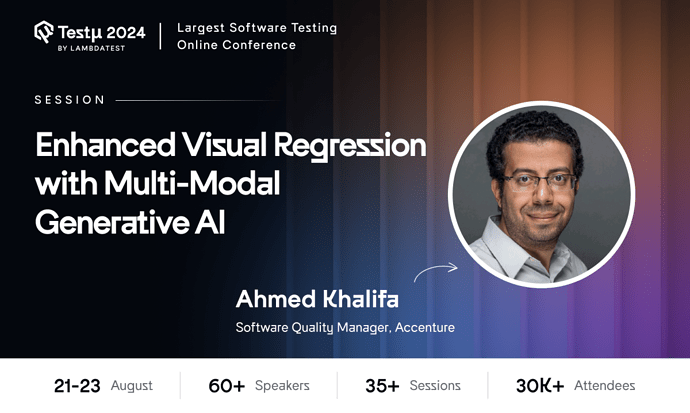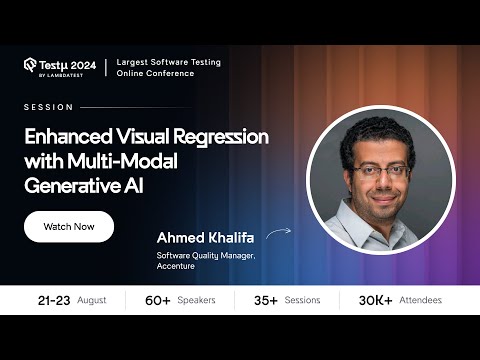 Discover how Ahmed, a seasoned software QA/Test engineer, is transforming visual regression testing using multi-modal generative AI. This session introduces an innovative approach that streamlines data validation and enhances design change detection through AI-powered analysis of web pages and UI components.
Discover how Ahmed, a seasoned software QA/Test engineer, is transforming visual regression testing using multi-modal generative AI. This session introduces an innovative approach that streamlines data validation and enhances design change detection through AI-powered analysis of web pages and UI components. 
Experience a live demo showcasing the practical application of this cutting-edge technology and learn how AI can automate and improve test case generation, ensuring your UI remains consistent and accurate. 
Still not registered? Don’t miss out—grab your free tickets now: Register Now!
Already registered? Post your questions in the thread below 
Hi there,
If you couldn’t catch the session live, don’t worry! You can watch the recording here:
Additionally, we’ve got you covered with a detailed session blog:
Here are some of the Q&As from this session:
How can we integrate this with legacy systems?
Ahmed Khalifa: When working with legacy systems, it’s crucial to approach integration thoughtfully. Rather than trying to integrate everything at once, start small and choose specific areas where new technologies can be effectively applied. In my projects, for instance, we have various quality engineering capabilities, including test analysis, automation, design, and strategy. We explore how generative AI can enhance these areas, starting with small, manageable tasks to assess improvements.
It’s also important to remember that the effectiveness of generative AI heavily depends on the quality of the input data. If the input from a legacy system is incomplete or lacks necessary information, the output may not meet expectations.
How do you ensure the accuracy & reliability of test cases generated by multi-modal generative AI?
Ahmed Khalifa: It’s crucial to have a human in the loop when using generative AI. While these systems can be incredibly helpful, you shouldn’t rely entirely on their outputs. It’s important to assess and verify the results yourself. Generative AI can provide a strong starting point and save you time, but ensuring reliability and accuracy still requires human oversight.
Can visual AI handle and test dynamic elements like Videos Ads, Picture Ads, etc. in a webpage?
Ahmed Khalifa: I haven’t used it for every daily task, but I did test its capabilities to showcase trends. What I found was that it effectively managed tasks such as handling pop-ups or entering codes to bypass screens. It worked well out of the box.
Additionally, I used it for video analysis, and it performed exceptionally. The system could slice videos into frames and accurately understand their content. Overall, it appears to be capable of handling various tasks involving video and image analysis effectively.
Here are some Unanswered Question that were asked in the session:-
How can organizations validate the reliability of AI-generated visual test cases and ensure they reflect realistic user experiences?
Can you share any real-world examples of how multi-modal AI has enhanced visual regression testing?
What challenges did you face in implementing multi-modal generative AI for visual regression testing & how did you overcome them?
Is it same as experience based testing when comes to functional aspects of testing? or Review based testing
Does this mean we can use Visual regression for web based front end testing - Appearance, color, etc and Dashboard testing?
Can we integrate design tools like Figma as the visual input - to test live output such as webpages?
Can this be used to test mobile apps on all platforms?
In my own experience, Organizations can validate AI-generated visual test cases by:
-
Cross-Referencing with Manual Tests: Compare AI-generated tests with manually created tests to identify discrepancies and ensure coverage.
-
User Acceptance Testing (UAT): Involve end-users to validate that the visual tests accurately reflect realistic user experiences and meet usability standards.
-
Continuous Monitoring: Implement monitoring tools to track performance and user interaction, ensuring the tests remain relevant as the application evolves.
Here are the Examples which include:
-
Visual Testing Tools like Applitools: They utilize multi-modal AI to analyze screenshots and detect visual differences across different devices and environments.
-
Mabl: This tool integrates various data inputs (like user behavior and UI changes) to enhance visual regression testing by making it more context-aware.
Yes, we can integrating design tools like Figma can streamline visual testing by providing design specifications that can be compared against the live output. Tools like Figma’s API can facilitate the extraction of design elements to automate visual regression tests.
Yes, visual regression testing can be applied to mobile apps across all platforms (iOS, Android) using tools that support responsive design testing and device emulation. This ensures visual consistency across various screen sizes and resolutions.
Thank you for your insightful question regarding the challenges of implementing multi-modal generative AI in visual regression testing, as discussed in Ahmed Khalifa’s session at Testμ 2024.
Challenges Faced:
-
Data Quality and Variability: One of the major challenges in implementing multi-modal generative AI is ensuring the quality and consistency of input data. Visual regression testing often involves analyzing a wide range of UI components, each having subtle design variations, which can confuse traditional AI models. High-quality, labeled datasets for these visual elements are crucial but often difficult to obtain in large quantities.
-
Accurate Detection of Minor UI Changes: Detecting subtle design changes (e.g., color shifts, font variations) without misclassifying acceptable variations as bugs is another challenge. Traditional AI models may either miss these slight changes or over-report irrelevant ones, affecting the reliability of the testing process.
-
Integration with Existing Testing Pipelines: Seamlessly integrating multi-modal generative AI with existing regression testing workflows presents technical difficulties, particularly in syncing the AI model’s output with ongoing test automation tools and CI/CD pipelines.
How These Challenges Were Overcome:
-
Leveraging Diverse Training Data: To address data variability, Ahmed’s team employed a multi-modal approach that incorporates different types of data inputs (e.g., images, text, and metadata). This enhances the AI’s ability to recognize patterns across diverse UI components and builds a more robust model that can handle data inconsistencies effectively.
-
AI-Powered Change Detection: They implemented a layered AI model, which focuses not only on pixel-to-pixel comparison but also on the semantic understanding of design components. By teaching the AI to understand the intent behind design elements, the system can accurately differentiate between minor visual changes that are acceptable and those that are actual design flaws.
-
Smooth Integration with Existing Pipelines: The team worked to ensure the generative AI solution could be easily integrated with popular CI/CD tools and automation frameworks. This was achieved by developing API-based connections that streamline the transition between visual testing and deployment, ensuring that the AI fits into the existing testing workflow without disruption.
Overall, the key to overcoming these challenges was a multi-pronged approach involving high-quality data, intelligent AI design, and seamless integration into the test environment. This innovation has significantly improved the accuracy and efficiency of visual regression testing.
Thank you @LambdaTest for your follow-up question regarding whether multi-modal generative AI for visual regression testing is similar to experience-based or review-based testing when it comes to functional aspects. While they all play a role in ensuring software quality, each approach has distinct objectives and methodologies, especially when focusing on functional testing.
Multi-modal generative AI in visual regression testing primarily addresses the visual consistency of user interfaces. It automates the detection of design changes by comparing current UI elements to their previous versions. This ensures that design aspects, such as layout, color schemes, and typography, remain consistent across different browsers and devices. However, when it comes to functionality, this AI-driven approach is not a substitute for functional testing. Its core strength lies in visual verification, ensuring that UI components appear as expected, but it does not evaluate how the software behaves or interacts with users.
Experience-based testing, on the other hand, is much more focused on the functionality of the software. In this approach, testers rely on their knowledge and intuition to explore the application and uncover potential bugs or issues. It’s a more flexible and subjective method that allows testers to identify edge cases or unusual behaviors that may not be covered by automated testing. This type of testing focuses on how the software works, how users interact with it, and how well it meets their expectations—elements that visual regression testing does not cover.
Similarly, review-based testing is quite different from both AI-driven and experience-based approaches. It involves reviewing software artifacts such as code, documentation, or test cases to identify potential flaws early in the development process. While important for improving overall quality, review-based testing does not directly involve running the application or testing its functionality, but rather ensures that design and code structures are solid before implementation.
Thank you for your follow-up query. I will surely try to give the answer:-
Yes, visual regression testing can absolutely be applied to web-based front-end testing, including aspects such as appearance, color schemes, and layout consistency. It is particularly useful in ensuring that any visual elements—whether it’s a minor color change or a more significant layout modification—remain accurate across different browsers and devices after updates or code changes.
When it comes to web front-end testing, visual regression ensures that your UI elements, such as buttons, fonts, images, and spacing, are displayed exactly as intended. This is crucial in preventing design issues that can negatively affect user experience. The tool compares current screenshots of the web pages to previous baselines, helping detect visual discrepancies that manual testing could easily miss, especially when dealing with large-scale or complex UIs.
For dashboard testing, visual regression becomes even more essential. Dashboards often contain dynamic components such as charts, graphs, and interactive widgets. With the help of visual regression, you can ensure that these elements are rendered correctly and consistently, preventing issues like misaligned graphics, broken layouts, or incorrect color displays. This kind of testing is invaluable when maintaining the clarity and readability of data-heavy UI components, which are central to dashboards.
It’s important to note, however, that visual regression focuses solely on the visual aspects—appearance and layout—of the front-end and dashboards. It does not test functionality. For a complete test strategy, it’s recommended to pair visual regression with functional testing to ensure that both the look and the behavior of the web application or dashboard are flawless.
![]() Discover how Ahmed, a seasoned software QA/Test engineer, is transforming visual regression testing using multi-modal generative AI. This session introduces an innovative approach that streamlines data validation and enhances design change detection through AI-powered analysis of web pages and UI components.
Discover how Ahmed, a seasoned software QA/Test engineer, is transforming visual regression testing using multi-modal generative AI. This session introduces an innovative approach that streamlines data validation and enhances design change detection through AI-powered analysis of web pages and UI components. ![]()
![]()
![]()

